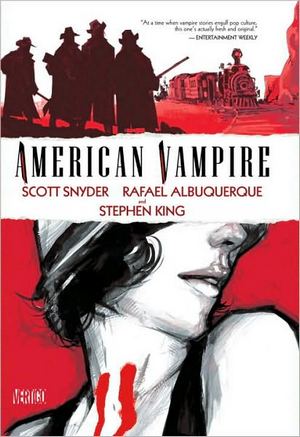- Comics
- Comics Reviews
- Manga
- Comics Reviews
- European Comics
- News
- Comics News
- Press Releases
- Columns
- Spotlight
- Digital Comics
- Webcomics
- Cult Favorite
- Back Issues
- Webcomics
- Movies
- Toys
- Store
- More
- About
By Leroy Douresseaux
October 14, 2010 - 12:44
 |
| American Vampire Vol. 1 cover image is courtesy of barnesandnoble.com. |
American Vampire is an ongoing comic book series launched by DC Comics’ imprint, Vertigo, earlier this year. Created and written by Scott Snyder and drawn by Rafael Albuquerque, American Vampire is comprised of two intertwined character dramas that tell the story of a new breed of vampire, the American vampire.
One tale follows the first American vampire, a ruthless outlaw named Skinner Sweet (kind of like a combination of Sawyer from “Lost” and Billy the Kid). The other character drama follows Pearl Jones, a struggling actress in mid-1920s Hollywood. Pearl becomes dinner for a pack of snobby, Euro trash vamps before Skinner transforms and saves her. Horror fiction icon Stephen King wrote Skinner’s origin story, which took up half of each of American Vampire's first five issues. DC Comics recently collected issues #1-5 in a hardback volume simply entitled, American Vampire.
Stephen King also writes an introduction to this volume (which he titled, “Suck on This”). King practically engages in the written equivalent of verbal gymnastics to insist that the vampires in American Vampire are how vampires should be – killers on the prowl to feed. He even manages to take swipes at True Blood/Sookie Stackhouse and especially Twilight (whose author, Stephenie Meyer has been the target of King’s criticism). King insists that American Vampire is oh-so original, although quite a bit of it resembles 30 Days of Night (comic books and film) and Blade (comic books and films). Originality is overrated anyway.
Begging Mr. King’s pardon, but vampires can also be enthralling and hypnotic. The reader or viewer should really want a vampire – want to see more of the vampire or even be with the vampire. From the unforgettable Dracula and the reptilian Nosferatu to Kiefer Sutherland’s bad boy, David, and the chivalrous, dreamy Edward Cullen, vampire characters need to grab imaginations even more than they play on our fears.
Skinner Sweet is a lowdown, mean, murderous mutha, but Snyder makes him the classic, alluring, my-own-way outlaw. Oh, the places he will go; the things he will do – with us in tow. Actually, I think Snyder has created an even better character in Pearl Jones. Plucky and sturdy, this young working woman of the 1920s could certainly survive the Depression even if she weren’t a vampire. The characters, leads and supporting, are what make American Vampire an excellent read, and Skinner and Pearl are the driving force.
Many Vertigo titles are quite enjoyable; one may discover this even after reading only one issue of practically any Vertigo series. Honestly, American Vampire is one of those goodies. Try one issue. Sure, many of you may run back to Attack of the Amaretto Lanterns or Mark Millar’s latest vanity ejaculation comic. However, those readers that have always wanted a good, ongoing, vampire comic book series to follow have one in American Vampire. In time, we may even call American Vampire great.
This American Vampire collection includes some excellent extras. It reprints all five variant covers of the original series, including covers by Jim Lee, Andy Kubert, and a killer piece by the great Berni Wrightson. There are script pages by Snyder and King with Rafael Albuquerque’s corresponding art for those pages (which are as good in black and white as they are in color). This book also offers examples of Albuquerque’s sketch art for this series.
A-